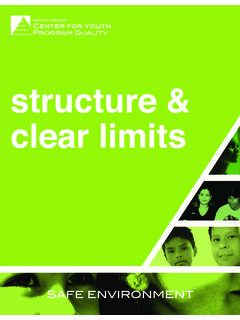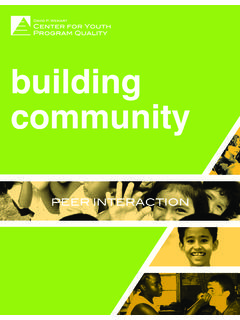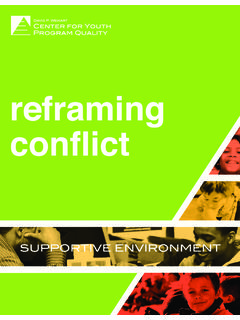Transcription of •e David P. Weikart Center for Youth Program €uality,
1 The David P. Weikart Center for Youth Program Quality, ! " " " # $ $ " $ " % " & & " & " ' ( ) * + . ! ! , ! % " & ' ) ! " . " " ! - ! . " & & ! % " & & ! '. Bringing together over fifty years of experience and the latest research, ) * / ! * ! & ' ) & # " . $ $ " ! # " " * " " . 0. " * ! # * . ) * / # " ! " . & '. 1 2 3 4 5 6 7 8 2 6 4 9 : 3 4 5 ; 4 < = ; = > ? ? ? @ A B : C @ 2 6 D Ravi Ramaswami, Sarah Phillips, Gina McGovern, & Tom Akiva E F G H I F J F J H K H L M N O P Q Q R S T T. U V L J W X F J Y Z K [ F \ P G H J U ] ^ F H _ P V K ` F M K F V a L V b L W K [ U V L c V P d e W P Q H K Z N P J H G H I H L M L a f [ F O L V W d a L V b L W K [ g M G F I K d F M K ]. h R S T T f [ F O L V W d a L V b L W K [ g M G F I K d F M K ] i Q Q E H c [ K I V F I F V G F J ] U P V K I L a K [ H I V F j L V K d P Z Y F k W L K F J. L V W I F J P I Q L M c P I K [ F P W K [ L V I P M J K [ F O L V W d a L V b L W K [ g M G F I K d F M K P V F V F X L c M H l F J ] m L j P V K L a K [ H I.]]]]]]]]
2 J W Y Q H X P K H L M d P Z Y F V F j V L J W X F J L V K V P M I d H K K F J a L V X L d d F V X H P Q j W V j L I F I n H K [ L W K j V H L V j F V d H I I H L M. a V L d K [ F O L V W d a L V b L W K [ g M G F I K d F M K ]. O L V a W V K [ F V H M a L V d P K H L M L V K L V F k W F I K j F V d H I I H L M I N j Q F P I F X L M K P X K K [ F \ P G H J U ] ^ F H _ P V K ` F M K F V. a L V b L W K [ U V L c V P d e W P Q H K Z P K T R o U F P V Q p K V F F K N p W H K F q S T N b j I H Q P M K H N r H X [ H c P M o s T t u ]. U [ L M F v u w o ] t q T ] q t S S ] x d P H Q v H M a L y X Z j k ] L V c ] ^ F Y v n n n ] X Z j k ] L V c David P. Weikart Center for Youth Program Quality Acknowledgments ( & " # ! ! " " & " z ! { { ) * ( | } ~ " " " . { ' " } ~ ~ z ! { " * . " ! " { " ! & . * ' ( * ! z ! { # &. - ' ) * + - ! . " & ! & . " " " & ) * / '. ( ! * " # & & " ! - '. ) * " " ) * & - * ) " $ " .. ( ( * " ) " $ " / z / &. z + " z + " { / & '.}}}}}
3 ( ) * + " " " * * * ! ! # ) ! ! . " ! " ) * / z ! { ". ! " ! , '. table of contents Introduction 1. Positive, Purposeful Interaction 2. The Method 5. Overview: Guiding Principles 6. Ask Effective Questions 8. Listen Actively 10. Encourage Success 11. Practice Activities 15. Converting Convergent Questions 16. Ms. Johnson 17. Distinguishing Praise From Encouragement 20. Alternatives to Praise 21. Extensions 23. Asking Questions with Depth and Variety 24. What? So what? Now what? 26. Roadblocks to Communication 27. Listening with Empathy 28. Is Praise Helpful or Harmful? 30. Across Age Groups 32. Across Content Areas 33. In Your Program 35. Planning for Questions 36. Sharing Ask-Listen-Encourage with Others 38. Resources 43. The Research 44. Ask-Listen-Encourage and the Active-Participatory Approach 52. The David P. Weikart Center for Youth Program Quality is a division of the Forum for Youth Investment *VW`YPNO[ -VY\T MVY @V\[O 0U]LZ[TLU[ (SS 9 PNO[Z 9 LZLY]LK ^^^ J`WX VYN.]]]}
4 Positive, purposeful interaction Ask-Listen-Encourage is a three-part Method, Why do adult- Youth interaction strategies matter? made up of three distinct but interrelated practices A key reason is that effective strategies can lead to designed to support Youth workers and educators as positive, productive relationships for young people they interact with young people. This guide provides with peers and the adults in their lives. Aside from detailed information for each of the three parts. In family members, the adults that many young people [OPZ ZLJ[PVU `V\ ^PSS UK H IYPLM IHJRNYV\UK HUK spend a substantial amount of time around are KLZJYPW[PVU VM [OL ILUL [Z VM LTWSV`PUN [OPZ TL[OVK usually teachers and other school staff. For Youth in Youth programs . that participate in out-of-school-time activities, Youth workers can also play a very important role in The Ask-Listen-Encourage Method was developed this social network; fostering positive relationships at the HighScope Institute for IDEAS, a residential with Youth and supporting them as they grow into summer Program for teenagers that operated in adulthood.]]]]]]]
5 Ask-Listen-Encourage provides a clear Michigan from 1963-2005. Staff used the method framework for purposeful interaction for Youth to support Youth in a wide variety of activities: workers and educators. science, language, and social studies workshops;. work projects involving construction, welding, and While this method encompasses three distinct skills, SHUKZJHWPUN" UL HY[Z WYVNYHTTPUN PUJS\KPUN T\ZPJ the three depend on each other in order to form a dance, and painting; community building activities complete method of positive, purposeful interaction. PUJS\KPUN JVTT\UP[` TLL[PUNZ JVU PJ[ YLZVS\[PVU This guide will provide you with the building blocks and community cleanup. The method provided staff of positive relationships; this method focuses on with the opportunity to formalize learning within a being purposeful in your interactions with Youth , camp setting, which led to consistent, positive results empowering Youth to become more autonomous and for the Youth involved in the Program .]]]]]
6 ZLSM JVU KLU[ HUK KLTVUZ[YH[PUN [OH[ `V\ NLU\PULS` . care for young people's well-being. In addition, The Ask strategy is about asking effective questions, improved relationships with Youth can positively engaging Youth in dialogue, and promoting critical affect Youth motivation and learning in the activities thinking. Listen is about being attentive to Youth offered at your Program . when they speak and showing support through LTWH[O` ,UJV\YHNL PZ HIV\[ THRPUN ZWLJP J . observations about the decisions and actions of young people as they work, encouraging them to succeed without resorting to judgment. c :LUK HU` JVTTLU[Z HIV\[ [OPZ N\PKLIVVR VY 4L[OVK [V! JVTTLU[Z'J`WX VYN. overview: guiding principles Ask-Listen-Encourage is a method for carrying out positive, purposeful interactions with young people. The method includes practices that can both foster positive relationships with Youth and support young people in learning new skills.]]]]]]]]]]]]]
7 Three guiding principles underlie the strategies: c :LUK HU` JVTTLU[Z HIV\[ [OPZ N\PKLIVVR VY 4L[OVK [V! JVTTLU[Z'J`WX VYN. Be Purposeful Interaction is often something that Show that you Care Youth need to know that just happens, without thinking about the impact. they have a strong network of supportive, caring But everything you do with Youth matters, and they adults. By asking personalized questions, making pay attention to the way you interact with them contextualized observations and comments, and both when informally chatting and during planned always listening, Youth workers and educators can activities. Youth deserve high-quality, engaging clearly and consistently demonstrate that they care programming, and one of the marks of a high- about every aspect of a young person. quality Program is purpose and intentionality. Things are done for a reason, with the needs of the Youth These three guiding principles are carried out in the involved taken into consideration.]]]]]]
8 ZWLJP J ^H`Z ZOV^U PU [OL =LUU KPHNYHT HIV]L HUK . detailed on the next few pages. Empower Youth Because of their age, young WLVWSL VM[LU UK [OLTZLS]LZ PU H WVZP[PVU VM . disempowerment. Youth workers and educators can use the Ask-Listen-Encourage method to focus discussions on young people and acknowledge their accomplishments, which in turn serves to inspire JVU KLUJL HUK MLLSPUNZ VM JVTWL[LUJL . The David P. Weikart Center for Youth Program Quality is a division of the Forum for Youth Investment *VW`YPNO[ -VY\T MVY @V\[O 0U]LZ[TLU[ (SS 9 PNO[Z 9 LZLY]LK ^^^ J`WX VYN c 7. A Questioning Sequence: What? So What? Now What? ;OL >OH[& :V >OH[& 5V^ >OH[& ZLX\LUJL ^HZ VYPNPUHSS` KL]LSVWLK MVY L_WLYPLU[PHS [LHT IHZLK ZL[[PUNZ . HZ H ^H` [V OLSW H NYV\W KLIYPLM HM[LY H JOHSSLUNL VY HJJVTWSPZOTLU[ ;OL ZLX\LUJL OHZ ILLU \ZLK PU . U\TLYV\Z ZL[[PUNZ PUJS\KPUN ZLY]PJL SLHYUPUN JVYWVYH[L [LHT I\PSKPUN HUK YLOHIPSP[H[PVU 0[ PZ HU LMMLJ[P]L [VVS.)]]]]]]]]]]]]]]]]]]]]]]
9 MVY SLHYUPUN )V[O PUKP]PK\HSZ HUK NYV\WZ JHU \ZL P[ HUK P[ PZ H YLSH[P]LS` LHZ` JVUJLW[ [V RLLW PU `V\Y OLHK . HUK \ZL ZWVU[HULV\ZS` ^OLU ULLKLK . After an activity, young people are often eager to simply talk about what just happened. The What? section of this sequence provides the space for that to happen while leading into more complex questions about the circumstances and factors surrounding the experience. By providing scaffolding that supports Youth where they are at - wanting to share their immediate experience and then taking it a step further, the What? So What? Now What? sequence challenges young people to explore their experiences, make sense of them, and ultimately apply their learning. The examples provided come from the debrief period after an activity in which Youth had to cross an imaginary river as a team with certain rules and restrictions applied. What happened? What are the facts? How ,_HTWSL! do you feel about them?]]]]]
10 >OH[ OHWWLULK ^OPSL L]LY`VUL ^HZ WSHUUPUN&. >OH[ OHWWLULK K\YPUN [OL HJ[\HS YP]LY . 0U [OPZ Z[HNL VM YL LJ[PVU HZR `V\UN WLVWSL . WHAT? JYVZZPUN&. ZWLJP J X\LZ[PVUZ HIV\[ [OLPY L_WLYPLUJL . >OH[ ^LYL ZVTL VM [OL KPM J\S[PLZ `V\ OHK&. Be sure to ask questions related to feelings. /V^ KPK `V\ MLLS HIV\[ [OL Y\SLZ VM [OL . Use what you know about young people and HJ[P]P[`&. [OL L_WLYPLUJL [V MYHTL ZWLJP J X\LZ[PVUZ . How does this relate to your past experiences? Why did it happen this way? ,_HTWSL! Why does this matter? /V^ KPK `V\Y WSHUUPUN PTWHJ[ [OL V\[JVTL&. >OH[ KVLZ LHJO LSLTLU[ VM [OL HJ[P]P[` . SO WHAT? In this stage, help young people make represent in real life? connections between the experience and 0U [OL LUK ^O` ^LYL `V\ \U Z\JJLZZM\S&. their knowledge and background. This is /V^ KPK `V\Y YLSH[PVUZOPW ^P[O LHJO V[OLY . when young people begin to make sense of PTWHJ[ [OL HJ[P]P[`&. an experience. ,_HTWSL! >OH[ KPK `V\ SLHYU MYVT [OPZ HJ[P]P[` [OH[ ^L.]]]]]]]]]]]]]]]]]]]]]]]]]]]]]]]]]]]]]



